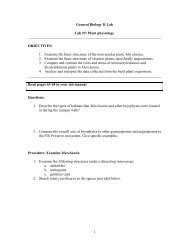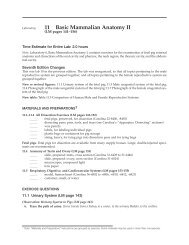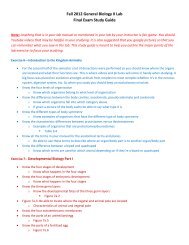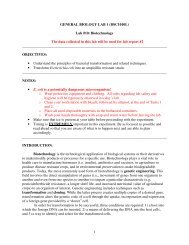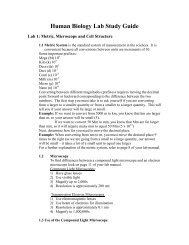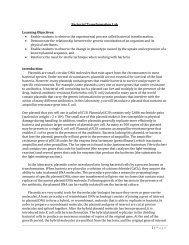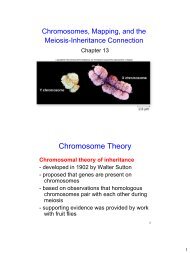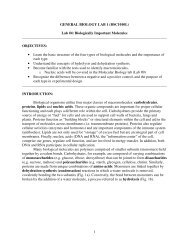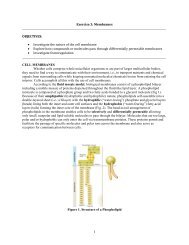Evolution (PCB 4674). Chapter 2. The evidence for evolution
Evolution (PCB 4674). Chapter 2. The evidence for evolution
Evolution (PCB 4674). Chapter 2. The evidence for evolution
You also want an ePaper? Increase the reach of your titles
YUMPU automatically turns print PDFs into web optimized ePapers that Google loves.
EVOLUTION/LECTURE1<br />
<strong>Evolution</strong> (<strong>PCB</strong> <strong>4674</strong>).<br />
<strong>Chapter</strong> <strong>2.</strong> <strong>The</strong> <strong>evidence</strong> <strong>for</strong> <strong>evolution</strong><br />
Main topics of lecture:<br />
I: <strong>The</strong> three main statements of the <strong>The</strong>ory of Special Creation<br />
1.- Introduction<br />
<strong>2.</strong>- Relatedness of life <strong>for</strong>ms<br />
3.- Change through time<br />
4.- <strong>The</strong> age of the Earth<br />
II: Correspondence among data sets and <strong>The</strong>ory of <strong>Evolution</strong><br />
I: General background:<br />
1.- Introduction<br />
1.1.- Be<strong>for</strong>e the establishment of the <strong>The</strong>ory of <strong>Evolution</strong> by Charles Darwin the leading<br />
explanation in Europe <strong>for</strong> the origin of species was the <strong>The</strong>ory of Special Creation. This<br />
theory held that all organisms were created by God during the six days of creation as<br />
described in the Bible's book of Genesis. <strong>The</strong> theory stated that species are unchanged since<br />
their creation, or immutable, and that variation within each species is strictly limited.<br />
1.<strong>2.</strong>- <strong>The</strong> <strong>The</strong>ory of Special Creation also stated that creation of all the organisms was recent<br />
(approx. 6,000 years ago).<br />
1.3.- By the time that Darwin began working with his theory dissatisfaction with the <strong>The</strong>ory<br />
of Special Creation had begun to grow. Research in the biological and geological sciences<br />
was advancing rapidly, and the data clashed with creationism's central tenets and predictions.<br />
1.4.- Scientific theories frequently have two components:<br />
(i) A statement of a fact: A claim about a pattern that exists in the natural world<br />
(ii) Which process is responsible <strong>for</strong> this patter<br />
1.5.- <strong>The</strong> three main statements of facts made by the <strong>The</strong>ory of Special Creation are:<br />
(i) Species were created independently of one another<br />
(ii) Species do not change through time<br />
(iii) Species were created recently<br />
1.6.- According to the <strong>The</strong>ory of Special Creation the process responsible <strong>for</strong> this pattern<br />
was the creation by God<br />
1.7.- In this chapter we will review <strong>evidence</strong> that supports an alternative statement:<br />
file:///E|/CH2-EVIDENCE-SPRING-2008/CHAPTER2_SPR_2008.HTML[12/8/2011 11:22:00 AM]
EVOLUTION/LECTURE1<br />
"Species have changed through time and are related by descent from a<br />
common ancestor"<br />
This statement is the backbone of the theory of <strong>evolution</strong> as exposed by Charles Darwin.<br />
1.8. In this chapter we will explore first data that challenges the three main statements of<br />
the <strong>The</strong>ory of Special Creation indicated in 1.5 (i.e. species are independent, immutable<br />
and recent). In the second half of the chapter we will introduce several data drawn from<br />
different fields of scientific inquiry that supports predictions of the <strong>The</strong>ory of <strong>Evolution</strong><br />
<strong>2.</strong>- Relatedness of life <strong>for</strong>ms and homology<br />
<strong>2.</strong>1.- <strong>The</strong> <strong>The</strong>ory of Special Creation contends that each species was created<br />
independently. In contrast the <strong>The</strong>ory of <strong>Evolution</strong> contends that organisms are related by<br />
common ancestry.<br />
<strong>2.</strong><strong>2.</strong>- Results from the fields of comparative anatomy and embryology demonstrate that<br />
fundamental similarities underlie the obvious physical differences among species. Early<br />
researchers called this phenomenon homology. Two good examples can be found in the<br />
vertebrate skeletons and in flower organs. If species share common ancestors they also<br />
should share many characters of their ancestors. Homologous characters reflect the common<br />
ancestry of species<br />
<strong>2.</strong>3.- Vertebrates <strong>for</strong>elimbs are used <strong>for</strong> different functions, but they ALL HAVE the same<br />
sequence and arrangement of bones.<br />
Figure <strong>2.</strong>1.a.: Vertebrate homologous bones. Homologous bones<br />
are colored or shaded in the same way, and are labeled on the<br />
human arm<br />
file:///E|/CH2-EVIDENCE-SPRING-2008/CHAPTER2_SPR_2008.HTML[12/8/2011 11:22:00 AM]
EVOLUTION/LECTURE1<br />
<strong>2.</strong>4.- Likewise orchid flowers are diverse in size and shape, but are comprised of elements<br />
that are similar in structure and orientation (Fig <strong>2.</strong>1.b)<br />
Figure <strong>2.</strong>1.b.: Homology among flower elements of two orchid<br />
species<br />
<strong>2.</strong>5.- Homologies can also be found at developmental, structural and embryonic levels. For<br />
instance the amino acid sequences encoded by a gene involved in the development of the<br />
eye exhibits 90% similarities among vertebrate and invertebrate organisms (Fig. <strong>2.</strong><strong>2.</strong>a)<br />
Figure <strong>2.</strong><strong>2.</strong>a.: Genetic homologies: <strong>The</strong> amino acid sequences of<br />
a section called the homeodomain in a protein involved in the<br />
development of the eye. Dots indicate the same amino acid as<br />
the one above<br />
<strong>2.</strong>6.- Advances in molecular genetics have revealed other fundamental similarities among<br />
organisms. One of the most spectacular is the genetic code. With a few minor exceptions, all<br />
organisms studied to date use the same nucleotide triplets, or codons, to specify the<br />
same amino-acid-bearing RNAs (Figure <strong>2.</strong><strong>2.</strong>b).<br />
Figure <strong>2.</strong><strong>2.</strong>b.: Genetic homologies: <strong>The</strong> genetic code; in almost<br />
every organism studied, the same nucleotide triplets, or codons,<br />
specify the same amino acid bearing transfer RNAs<br />
file:///E|/CH2-EVIDENCE-SPRING-2008/CHAPTER2_SPR_2008.HTML[12/8/2011 11:22:00 AM]
EVOLUTION/LECTURE1<br />
<strong>2.</strong>7.- Homology may appear to be an abstract concept. However, the concept of homology<br />
is the guiding principle behind most biomedical research. Homology is the reason medical<br />
researchers can obtain valid results when testing the safety of new drugs in rats. Results of<br />
these tests can be extrapolated to humans if the molecular or cellular basis of the phenomenon<br />
being studied is homologous.<br />
<strong>2.</strong>8.- Homology and Bio-Medical Research.- Bio-medical researchers choose a study<br />
organism - also called a "model" organism - based on the degree of homology required<br />
to study a particular process or disease. In psychiatry and the behavioral sciences,<br />
<strong>for</strong> example, monkeys and apes are often the preferred experimental subject<br />
because aspects of their behavior and brain structures are homologous with<br />
those of humans. Because some of the genes involved in more basic processes, like<br />
the cell cycle, are homologous between even distant relatives, researchers can use<br />
baker's yeast (Saccaromyces cerevisiae) to study why certain malfunctioning genes<br />
cause cancer in humans. At an even more fundamental level, the genes involved in<br />
DNA repair are homologous between humans and the bacterium Escherichia coli.<br />
Primates, yeast, and bacteria share these characteristics with humans because they<br />
inherited them from a common ancestor<br />
3.- Change through time<br />
3.1.- <strong>The</strong> second major statement of the <strong>The</strong>ory of Special Creation is that Species do not<br />
change through time. Evidence from living species and the fossil record challenge this<br />
view<br />
3.<strong>2.</strong>- Evidence from living species.- <strong>The</strong> existence of vestigial structures and direct<br />
file:///E|/CH2-EVIDENCE-SPRING-2008/CHAPTER2_SPR_2008.HTML[12/8/2011 11:22:00 AM]
EVOLUTION/LECTURE1<br />
observation of change of living species support the hypothesis that species change through<br />
time.<br />
3.3.- A Vestigial structure is a functionless rudimentary homologue of a body part that<br />
has a function in closely related species. For instance some blind, cave-dwelling creatures<br />
have eye sockets but no eyes, humans have a reduced tailbone, called the coccyx at the<br />
base of their vertebral column (Figs <strong>2.</strong>3.a and <strong>2.</strong>3.b)<br />
Figure <strong>2.</strong>3.a.: Rudimentary tailbone of humans<br />
Figure <strong>2.</strong>3.b.: <strong>The</strong> grotto salamander (Typhlotriton spelaeus)<br />
have functionless bulbs of tissue in place of eyes<br />
file:///E|/CH2-EVIDENCE-SPRING-2008/CHAPTER2_SPR_2008.HTML[12/8/2011 11:22:00 AM]
EVOLUTION/LECTURE1<br />
3.4.- Another example of a Vestigial structure can be found during the development<br />
of the "hands" (wing tips) and feet of birds. Adult chickens have three digits in their wings<br />
and four in their feet. But when chicken embryos are treated with a stain to mark the<br />
tissues that initiate bone development, and additional digit appears (in the wing and foot),<br />
and later disappears (Fig. <strong>2.</strong>4). Most living and fossil tetrapods have five digits in their<br />
<strong>for</strong>elimbs and hindlimbs. It is logical, then, to argue that the ancestors of birds also had<br />
five digits in each limb<br />
Figure <strong>2.</strong>4.: Adult chickens have three digits in their wings<br />
and four in their feet. But during development, an extra digit<br />
appears <strong>for</strong>t a short time in the hands and foot<br />
3.5.- Change through time can also be observed directly. Over the past 60 years, biologists<br />
have documented change in hundreds of different species!!!!. An example can<br />
be found in the soapberry bug in Florida. In the first part of the 20 th century, soapberry<br />
bugs [Jadera haematoloma (Hemiptera)] that were collected in Florida tended to have<br />
extremely long beaks. <strong>The</strong>se insects feed on seeds that are located within the fruits at<br />
varyring distances from the fruit perimeter. At that time the most important<br />
host plant <strong>for</strong> the bugs was the Florida native large-fruited balloon vine<br />
[Cardiospermum corindum (Sapindaceae), Fig. <strong>2.</strong>5.c; Sapindaceae is the plant family<br />
of the litchi tree]. In the mid 20 th century however, most populations of soapberry bugs<br />
began feeding on the small fruits of a plant that had just been imported from Asia as an<br />
ornamental species, called the flat-potted golden rain tree [Koelreuteria elegans (Sapindaceae),<br />
Fig. <strong>2.</strong>5.d]. Soapberry bugs collected after the host-plant switch tend to have much smaller<br />
beaks than older populations (Figs. <strong>2.</strong>5.a and <strong>2.</strong>5.b)<br />
file:///E|/CH2-EVIDENCE-SPRING-2008/CHAPTER2_SPR_2008.HTML[12/8/2011 11:22:00 AM]
EVOLUTION/LECTURE1<br />
Figure <strong>2.</strong>5.a.: Soapberry bugs feeding on the fruit of a balloon<br />
vine and a flat-podded golden tree<br />
Figure <strong>2.</strong>5.b.: <strong>The</strong> scatterplot shows the beak lengths of female<br />
soapberry bugs from Florida in a 100 year period<br />
file:///E|/CH2-EVIDENCE-SPRING-2008/CHAPTER2_SPR_2008.HTML[12/8/2011 11:22:00 AM]
EVOLUTION/LECTURE1<br />
Figure <strong>2.</strong>5.c.: Balloon vine[Cardiospermum corindum (Sapindaceae)].<br />
Soapberry bugs from Florida fed mostly on fruits of this vine until<br />
the introduction of the golden rain tree (Koelreuteria elegans<br />
(Sapindaceae)<br />
file:///E|/CH2-EVIDENCE-SPRING-2008/CHAPTER2_SPR_2008.HTML[12/8/2011 11:22:00 AM]
EVOLUTION/LECTURE1<br />
Figure <strong>2.</strong>5.d.: Golden rain tree (Koelreuteria elegans<br />
(Sapindaceae)<br />
3.6.- Evidence from the fossil record.- A fossil is a trace of any organism that lived in<br />
the past. <strong>The</strong> total, worldwide collection of fossils, scattered among thousands of different<br />
institutions and individuals, is called the fossil record. <strong>The</strong> simple fact that fossils exist,<br />
and that the vast majority of fossils <strong>for</strong>ms are unlike species that are living today, argues<br />
that life has changed though time<br />
3.7.- <strong>The</strong> law of succession. <strong>The</strong>re is a general correspondence between fossils and living<br />
<strong>for</strong>ms. <strong>The</strong> law of succession maintains that the fossil species found in a giving area are<br />
usually succeeded by similar living species of this area. For instance the extinct marsupial<br />
file:///E|/CH2-EVIDENCE-SPRING-2008/CHAPTER2_SPR_2008.HTML[12/8/2011 11:22:00 AM]
EVOLUTION/LECTURE1<br />
fauna of Australia has a close relationship to marsupials alive today in this region.<br />
Likewise Darwin analyzed the armadillos of Argentina and their close glyptodons he<br />
excavated there (Fig. <strong>2.</strong>9). Glyptodons went extinct around 10,000 years ago during the<br />
last ice age, after having lived in both North and South America<br />
Figure <strong>2.</strong>9.: Early researchers observed close relationships<br />
between fossil and extant species from the same geographical<br />
area, and between fossil <strong>for</strong>ms in adjacent rock strata, so<br />
routinely that the pattern became known as the law of<br />
succession. Darwin noted the similarities between the<br />
contemporary pygmy armadillo (Zaedyus pichiy) and the<br />
fossil of the giant glyptodont in Argentina<br />
3.8.- Transitional <strong>for</strong>ms. Darwin maintained that species have changed through time,<br />
and that fossils represent populations that are ancestral to species alive today. If this<br />
is true, then the fossil record should contain <strong>for</strong>ms that are transitional between<br />
file:///E|/CH2-EVIDENCE-SPRING-2008/CHAPTER2_SPR_2008.HTML[12/8/2011 11:22:00 AM]
EVOLUTION/LECTURE1<br />
major groups of organisms. <strong>The</strong>se transitional species should have characteristics from<br />
the ancestral population as well as novel traits in descendant species. One of the<br />
best known examples is the most ancient bird in the fossil record, Archaeopteryx.<br />
<strong>The</strong> presence of feathers clearly identifies this species as a bird, but the skeleton<br />
is dinosaur-like. Archaeopteryxrepresents a transition between ancestral dinosaurs<br />
and their descendant, the birds (See Figure below). <strong>The</strong> oldest fossil of<br />
Archaeopteryxis is estimated to be 150 million years old. Because few transitional<br />
<strong>for</strong>ms had been discovered in his lifetime, Darwin took pains to explain that they<br />
should be rare in the fossil record in a section os his book titled "Difficulties on<br />
<strong>The</strong>ory". In the intervening years, however a LARGE NUMBER OF<br />
TRANSITIONAL FORMS have been found<br />
3.9.- Environmental Change. Fossils of marine organisms have been discovered<br />
file:///E|/CH2-EVIDENCE-SPRING-2008/CHAPTER2_SPR_2008.HTML[12/8/2011 11:22:00 AM]
EVOLUTION/LECTURE1<br />
in the Andes in South America, the Alps of Europe, and the Grand Canyon of<br />
America's arid southwest. <strong>The</strong>se observations suggest that the Earth itself has changed<br />
over time. Habitats have changed in location and character throughout the course of<br />
history. Land<strong>for</strong>ms and habitats are continuously being modified, just as species are<br />
4.- <strong>The</strong> age of the Earth<br />
4.1.- <strong>The</strong> <strong>The</strong>ory of Special Creation establishes that the Earth is about 6,000 years old.<br />
However by the time of Darwin geological <strong>evidence</strong> was mounting that the Earth was<br />
much older.<br />
4.<strong>2.</strong>- Using the technique of relative dating geologists have established the chronology of<br />
relative dates known as the geologic time scale (Fig. <strong>2.</strong>11). <strong>The</strong>y also created the concept<br />
of the geological column, which is a geologic history of the Earth based on a composite,<br />
older-to-younger sequence of rock strata. Geologists began working in time scales of millions<br />
of years, instead of a few thousand years<br />
Figure <strong>2.</strong>11.: <strong>The</strong> geological time scale. <strong>The</strong> sequence of eons,<br />
eras, periods, and epochs shown on the left part of this diagram<br />
was established through the techniques of relative dating. Each<br />
named interval of time is associated with a distinctive fossil flora<br />
and fauna. <strong>The</strong> absolute ages included here were added much later,<br />
when radiometric dating system became available. <strong>The</strong> abbreviation<br />
Ma stands <strong>for</strong> millions of years ago<br />
file:///E|/CH2-EVIDENCE-SPRING-2008/CHAPTER2_SPR_2008.HTML[12/8/2011 11:22:00 AM]
EVOLUTION/LECTURE1<br />
4.3.- Using a technique called radiometric dating, physicists and geologists began to assign<br />
absolute dates to the relative dates established by the geologic timer scale. <strong>The</strong> technique <strong>for</strong><br />
radiometric dating utilizes unstable isotopes of naturally occurring elements. <strong>The</strong>se radioactive<br />
isotopes (parent isotope) decay, meaning that they change into either different elements or<br />
different isotopes of the same element (daughter isotope). Each isotope decays at a particular<br />
and constant rate. <strong>The</strong>se rates are not affected by temperature, moisture, or any other<br />
environmental factor. Researchers measure the ratio of parent isotope to daughter isotope<br />
in a rock sample. As a result, radioactive isotopes function as natural clocks. because of<br />
their slow decay rate potassium-argon and uranium-lead systems are the isotopes of choice<br />
<strong>for</strong> determining the age of the Earth (Fig. <strong>2.</strong>12).<br />
4.4.- <strong>The</strong> oldest fossil organism discovered to date are impressions of bacterial cells found<br />
in 3.5 billion-year-old rocks from Western Australia. <strong>The</strong> oldest chemical <strong>evidence</strong> (carbon<br />
granules) of life is in rocks from Greenland dating more than 3.7. billion years old. It is<br />
estimated that the planet is about 4.6 billion years old. <strong>The</strong>se data suggest that the Earth was<br />
lifeless <strong>for</strong> about 900 million years, and that <strong>evolution</strong> has been occurring <strong>for</strong> about<br />
3.7 billion years.<br />
file:///E|/CH2-EVIDENCE-SPRING-2008/CHAPTER2_SPR_2008.HTML[12/8/2011 11:22:00 AM]
EVOLUTION/LECTURE1<br />
II: Correspondence among data sets and <strong>The</strong>ory of <strong>Evolution</strong><br />
5.1.- <strong>The</strong> data reviewed in this chapter contradict the proposition that species were<br />
created independently, that species are immutable, and that the Earth is young. <strong>The</strong>se<br />
data are easily explained by the theory of <strong>evolution</strong>. <strong>The</strong>re is another type of data<br />
that also supports the theory of <strong>evolution</strong>. This is a correspondence among independent<br />
sources of data on Earth history and the history of life. Geologists interpret Earth history<br />
through the <strong>The</strong>ory of Plate Tectonics. This theory contends that the Earth's crust is<br />
broken into plates and that the positions of these plates have change through time. When<br />
the geological data are combined with radiometric dates and data from the fossil record,<br />
a coherent picture of change through time emerges.<br />
file:///E|/CH2-EVIDENCE-SPRING-2008/CHAPTER2_SPR_2008.HTML[12/8/2011 11:22:00 AM]



